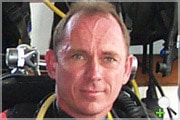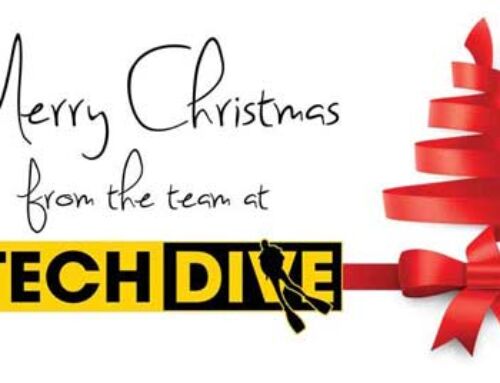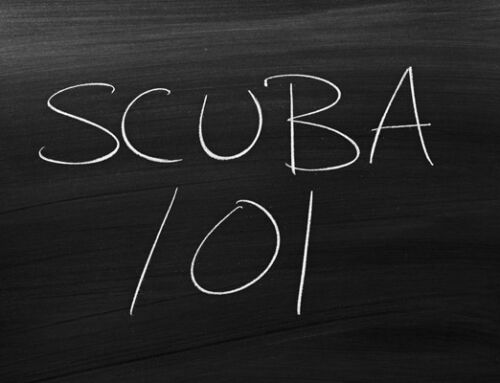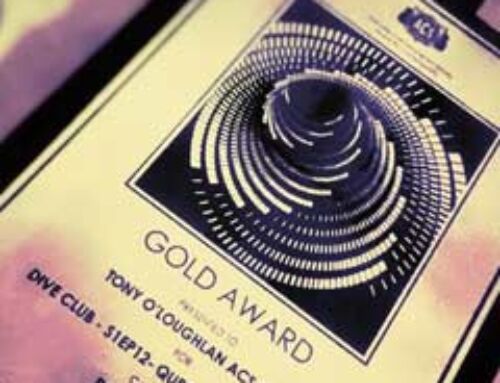A JOURNEY TO 308 METRES
THE DEEPEST OPEN CIRCUIT SCUBA DIVE EVER*
* The current verified record is 332.35m (2014) by Ahmed Gabr.
15 Years have passed and we look back…
John Bennett
“Naturally like any explorer I have been asked what I intended to find, and whether it made sense to take avoidable risks. I did not expect to find pirates gold in brass-bound boxes, it’s more the feeling of adventure, the great feeling of putting your foot where no other has been before.” George Benjamin – This was John’s favourite quote.
Long regarded as the four-minute mile of open circuit scuba diving the depth of 305m (or 1,000 feet) marks the goal of those in the deep diving community striving to go deeper than anyone before.
These divers fall into their own category for although many divers have been deeper before (in fact those that use submersible bells, surface supplied gas and other commercial rigs regularly dive and work at deeper depths) those on open circuit face infinitely greater risks; it’s no exaggeration to say that they are working at the very limits of physiological knowledge.
In the world of open circuit many world record depth attempts are made in fresh water sink holes. The relatively ‘ideal’ conditions of these environments make the staging of tanks and logistics that much easier than those who face the more uncertain conditions of open waters. Unpredictable currents, surface conditions and a massive difference in surface and bottom temperatures are just some of the environmental factors taken into consideration.
John Bennett was no stranger to the logistics, stress and hazards involved in pushing depth limits; on June 4, 2000 John made a solo dive to 254m / 838feet (that stood as the world record for depth on open circuit scuba in the open ocean until this dive) in the beautiful waters off Puerto Galera on the island of Mindoro in the Philippines.
John knew at the time he could go deeper and soon started making plans to break the 1,000 foot mark; for John, the ultimate dive lay ahead. Once the decision had been made to do the dive the hard work begun, months of planning and training preceded the dive itself. The equipment configuration alone caused a delay of two months and even with all the team assembled in September the dive was put back to November.
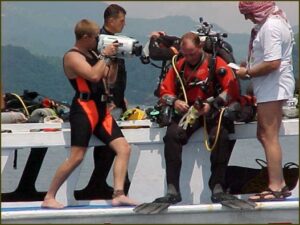 The original quad pack on John’s back had been awkward and restricted movement, he opted for a more flexible set up that consisted of a triple pack of OMS low-pressure 20liter tanks required to carry the huge amounts of bottom gas he would consume (over 620 litres per minute on the bottom; that’s a regular scuba tank every four minutes). John also strapped a forth 5.5 litre tank behind the triple set for dry-suit inflation. OMS also provided a specially constructed canister light that was placed between the left hand tanks. Two side slung 11.1-liter tanks made up the last part of the tank rig – these would be used for the first two gas switches in 150m/500feet and 90m/300feet of water; from there on up John would rely on the support divers to supply decompression gas.
The original quad pack on John’s back had been awkward and restricted movement, he opted for a more flexible set up that consisted of a triple pack of OMS low-pressure 20liter tanks required to carry the huge amounts of bottom gas he would consume (over 620 litres per minute on the bottom; that’s a regular scuba tank every four minutes). John also strapped a forth 5.5 litre tank behind the triple set for dry-suit inflation. OMS also provided a specially constructed canister light that was placed between the left hand tanks. Two side slung 11.1-liter tanks made up the last part of the tank rig – these would be used for the first two gas switches in 150m/500feet and 90m/300feet of water; from there on up John would rely on the support divers to supply decompression gas.
John’s tough physical regime over the months preceding the dive was aimed at maintaining a very high level of aerobic, cardio-vascular and muscular fitness and consisted of ten workouts each week, five aerobic and five muscular. Diet was also important and John supported his training by eating four times each day, keeping the carbohydrates high, proteins moderate and fats low.
Puerto Galera, Philippines was again the location chosen for the 1,000 foot dive; not only did John feel more comfortable and rested working from home but the easy access to deep water and ample supplies of gas, warm surface water and relatively good surface conditions made it a good all round choice.
John’s June 2000 dive had gone very smoothly and as a result the team incorporated many of the techniques employed then, one of which was the use of a specially built free floating decompression platform that allows a vertical decent line to be employed with a four bar trapezium assembled in shallow water for the longest decompression stops. The unique design allows the platform to be cut free if necessary and drift with the current while keeping essential support mechanisms in place.
The team of divers that support John are another key part of any successful dive and the November team remained almost unchanged from the June 2000 dive: Mark Cox, Targa Man, Ron Loos, Axel Lechwald, Kfir Zorev and Portuguese depth record holder Jorge Marques are all experienced deep divers many of whom John trained personally. It’s no coincidence when you find a group of dedicated people in one location – all specialists in their fields – John has attracted a team around him that made Atlantis Tech stand out.
Other experienced deep divers including Frank Doyle and Jongin Lee would join the team closer to the day itself and prove essential to the dive’s success. Equally essential was Joe McLary, a veteran paramedic who flew in from Hawaii to take care of contingency medical procedures (although at one point it seemed uncertain whether he could make it, the team’s decision to make some last minute calls and Joe’s own decision to do little short of threaten to resign to get the time off work proved invaluable on the day).
Their work intensified the week before the dive, briefings and discussion sessions were planned to ensure that each knew their role. This was a long and complex process as John would be working from seven potential profiles and even though an abort at relatively shallow depths would be probably be easily handled and gas problems minimal, an abort at 200m/ 660ft or deeper could still lead to complex in water situations.
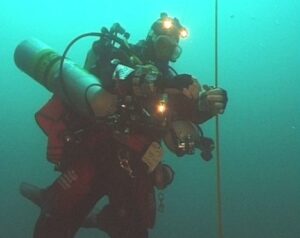 Depths were set for the support divers: 90m/ 300ft, 66m/ 215ft and 36m/ 120ft, then 21m/ 70ft and the shallow stops. Arguments regarding the deep stop persisted: John had asked for no one to be deeper than 90m/300ft to reduce the risk to members of the support team (in other attempts support divers have perished) but the fact that no one would know what was going on until this depth was of great concern along with psychological effects on John. The end compromise was a series of tanks clipped to the line at depths below 90m/300ft. The deeper support divers also needed support and contingency planning, the plans got ever more complex. These divers would send a slate to the surface to indicate the start times and profiles the support divers would be working to but everyone had to calculate gas mixes and consumptions to account for a variety of situations.
Depths were set for the support divers: 90m/ 300ft, 66m/ 215ft and 36m/ 120ft, then 21m/ 70ft and the shallow stops. Arguments regarding the deep stop persisted: John had asked for no one to be deeper than 90m/300ft to reduce the risk to members of the support team (in other attempts support divers have perished) but the fact that no one would know what was going on until this depth was of great concern along with psychological effects on John. The end compromise was a series of tanks clipped to the line at depths below 90m/300ft. The deeper support divers also needed support and contingency planning, the plans got ever more complex. These divers would send a slate to the surface to indicate the start times and profiles the support divers would be working to but everyone had to calculate gas mixes and consumptions to account for a variety of situations.
There were practical considerations: Axel worked tirelessly to assemble he platform and layout, tag and measure the line, Mark, Kfir and Frank spent hours blending gases, Jongin prepared the camera, Targa prepared profiles, laminated them and took care of much of the logistics with Tony Gower who joined the team from Hong Kong and took on the role of coordinator. Food and drink had to be prepared, boats organized as well as the numerous extra tanks, clips, slates and equipment to make the dive work. Joe assembled the emergency kit, contacted the recompression chamber (who kindly agreed to postpone a major overhaul) and made evacuation plans. There were practice sessions with the platform and John’s equipment exchange. In addition the team dove, ran and trained to stay ready. The big day drew closer.
Although John had originally planned a series of dives over the week it became apparent from the amount of work going on that this would not be practical, but before this became an issue John let the team know he had decided some time before that it would Tuesday or nothing. The final meeting was subdued as the final arrangements were confirmed and Joe ran through the medical contingencies for everyone involved. Tables were ‘cut’ for this special dive using Abyss software and despite a bottom time of just a few minutes his total dive time would be over nine and half hours. The dive incorporated six different trimix blends and although his use of large amounts of helium at all stages of the dive is somewhat experimental in dives to date he has made the decompression ‘cleaner’, cut back on CO2 problems and increased the ease of breathing. Even normal air breaks have been replaced with switches back to trimix aimed at buffering the oxygen clock (protecting against oxygen toxicity), reversing vassal constriction (caused by breathing high Partial Pressures of Oxygen (PO2’s), reversing pulmonary edema (caused by breathing high PO2’s) and cutting back on the amounts of CO2 retained.
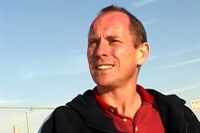
By 8am everyone was on the move, although from a daylight perspective it would have been better to start earlier the tide changes meant there was little chance of John entering the water before 9am.
John travelled out on the medical chase boat, accompanied by a couple of the support team he begun to focus on the job in hand. The site was about fifteen minutes from the beach and on arrival John was transferred to the MV Galera where he could begin gearing up. As he did so two slates were prepared and signed by Atlantis Dive Resort General Manager and PADI Course Director Andy Pope and IANTD Philippines Franchise holder Alex Santos. One was clipped to the bottom of the line and sent of the edge attached to over 320m of chain and rope, just below the incredible camera that would capture the morning’s events. The other was given to John leaving him the choice either clipping on or pulling off to verify the depth he reached.
Things were running relatively smoothly, the depth had been verified with a sounder, conditions were calm and despite a couple of hitches the line was now out. John checked his equipment set up, it was, he believed the best available. The words of Tony Gower, who had become a pillar of strength within the team, echoed as John stepped over the side: ” John you just do the dive and leave the rest to us”. It was now or never.
At 9.10am John begun his descent, initially much slower than he had wanted; he reached the 90m/ 300ft switches after 3minutes 45 and it was only after 120m/ 400ft that he begun to speed up. The 130m/ 430ft spare-tank passed and the darkness came, with the darkness came the cold. This was his seventh time below 155m/ 510ft, so the transformation was not such a shock and the descent continued uneventfully. He focused in on his position in the water column, his remaining gas supply and monitored for signs of HPNS (High Pressure Nervous Syndrome).
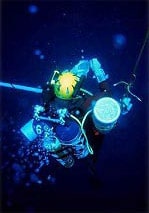
On the surface the 90m/300ft support divers had already descended and many of the others were already in the water preparing, a short run time would not give them much time to prepare. As the minutes ticked by Andy Pope and Tony Gower who had been left to run things realized that either John was close to the 1, 000 foot mark… or that he wasn’t coming back.
John had reached the 275m/ 905ft marker and was still going down, the tremor had become more pronounced and his vision was blurred. He knew it was HPNS, but was within manageable limits, the Apeks TX 100’s were still breathing superbly each with no increase in resistance. John shone the OMS light down, nothing, just the light disappearing into black. Slowly the lights of the camera (Jongin Lee had made the camera casing in one day and much to National Geographic’s amazement it worked) appeared as a distant glow and gave John a target. He hit the inflator mechanism but the line kept slipping through his hand.
In what seemed like eternity the OMS 100lb wings filled, he inflated the dry-suit as well the light was getting closer, he knew that if he hit the end of the line too fast he would just fall off the end. The camera was on him and although still negative he could stop. On checking his gas there was 100bar left plus 180bar in the single OMS 20L. He unclipped the slate and wedged it into a knot, after a quick glimpse into the darkness he was on his way back up. The minutes ran over John’s longest possible run time to reach 90m/300ft, Andy and Tony begun to fear the worse… still no balloon. Then a yellow mark on the surface was spotted and there was a mad rush… but it was nothing more than a plastic bag.
John was ascending slowly, he passed the 200m/ 660ft tank and slowed to 15m/ 50 feet per minute pausing for 20 seconds first, he repeated this at 175m/ 580ft.
He made his first gas switch at 150m/ 500ft and extended the stop time to a full minute. As he turned the valve of the tank it free flowed wildly, sending a cloud of bubbles to the surface. After quickly taking a breath he shut down the valve and only opened it to take a breath. He reached the 130m/ 430ft spare tank and breathed a sigh of relief and continued up. Ron and Mark were waiting at 100m and John indicated which profile he was on, the balloon was sent to the surface. Meanwhile Axel had been put in the water by Andy & Tony and prepped to go to 90m/ 300ft… a move they knew would throw out other support roles later in the dive but there were no other options left… they were now looking at last resorts… shouts went up as the balloon hit the surface and Axel was stopped just seconds from his descent. After a highly emotional few minutes the team re-established roles as they confirmed the profile everyone would work to for the next nine hours.
Frank Doyle and Kfir Zorev met John at 66m/ 220ft and although everything appeared to be going well as John left the stop he was hit by a wave of vertigo and he spent the next 10 minutes vomiting violently, he didn’t know which way was up. As he settled he checked his gauge and noted he had burned through his mix quickly. He looked at Frank and felt comfort from the calm eyes that came with years of dealing with problems underwater. They resumed the job in hand and continued ascending. Frank extended his long hose when John reached 50bar, the contingency planning had ensured that all of the team was breathing John’s mix at their time of support; he remained on his decompression schedule. Targa Man and Axel Lechward along with paramedic Joe Mclary replaced Frank and Kfir who were left to ascend.
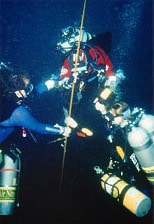
On the surface news spread that John had reached the 305m/ 1,000ft mark but the work was far from done and as the team realized John still had major problems to overcome plans were made to get extra gas and divers from friendly stores; it was going to be a long day. Joe had stayed in the water far longer than planned and although cold and fatigued he was to spend much longer in the water before the day was up. He and Andy Pope decided that evacuation plans had to be put into place; boats were made ready and ambulance put on standby. There were long telephone calls with dive doctors as they planned for the worse case scenarios. The weather had also turned and stormy showers made it difficult for the support team to stay warm.
John has said since that as he very literally “toughed it out” he just kept reminding himself that no one had asked him to do this dive, he was there of his own choice. The hours went by slowly as the team rotated round keeping at least two divers with John at all times. The good news was that John appeared to be recovering and became more aware as the time went by and a fellow tech diver had also arrived to ensure that the decompression schedule was adhered to.
John was amazed at the faces that appeared before him; other Puerto Galera Instructors had come to see if they could help, none asked for anything in return, some spent several hours in the water. Every 15 minutes he switched back to a Trimix 16/44 for 5 to 8 minutes. This was done at the 21m, 12m and 6m stops. This eased the damaging effects of breathing high PPO2’s for too long.
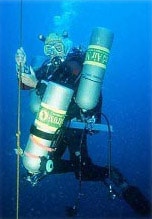
Nine hours and thirty-seven minutes after leaving John surfaced surrounded by familiar smiling faces, fatigued but jubilant. He was quickly taken back to the resort under the watchful eye of Joe and put on a drip to replace lost fluids. Friends monitored him throughout the night.
It was resolved that the vertigo and vomiting were caused by an inner ear bara-trauma. John was back managing Atlantis Tech the following day and returned to training, diving and teaching two weeks later.
Footnotes
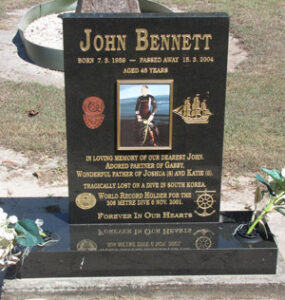 One of the major problems with this style of dive is actually verifying you have the depth. With no depth gauges a measured line is the only way. John used a free hanging line lowered under supervision. After it was lowered he was given a signed slate, which I had to clip off on the bottom. This was then raised after John transferred to the platform trapezium. It was then measured on dry not taking in to account “stretch factor” caused by over 70kg of weight attached to the bottom.
One of the major problems with this style of dive is actually verifying you have the depth. With no depth gauges a measured line is the only way. John used a free hanging line lowered under supervision. After it was lowered he was given a signed slate, which I had to clip off on the bottom. This was then raised after John transferred to the platform trapezium. It was then measured on dry not taking in to account “stretch factor” caused by over 70kg of weight attached to the bottom.- John first broke the record in 1999 reaching 200m with Chuck Driver, then again in 2000 John set a new record of 254m, before his next recording breaking dive in 2001 to 308m. His record stood until 2005.
- John was tragically lost on a Commercial dive job off South Korea on 15 March 2004.

